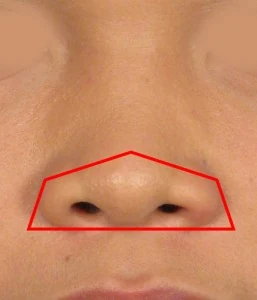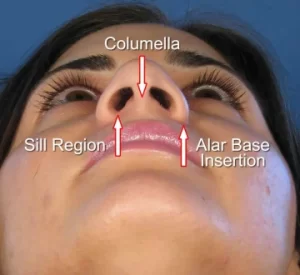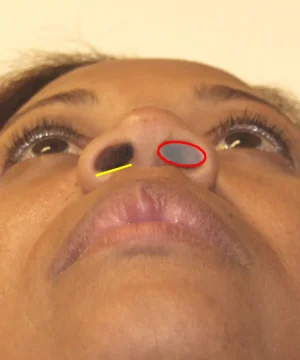Nasal base reduction refers to a rhinoplasty maneuver that is intended to narrow the base of the nose in cases where it is excessively wide for the face. Nasal base reduction of some form or another is fairly common in rhinoplasty and revision rhinoplasty. It is done even more frequently when performing ethnic rhinoplasty, including work on Asian noses, African American noses, and Middle Eastern noses. These particular patient populations tend to have a slightly wider nasal base making nasal base reduction more necessary to refine the nose.

Most rhinoplasty and revision rhinoplasty patients seeking out nasal base reduction present with a chief complaint that their nose looks too wide or too big at the bottom. The nasal base area is shown in the adjacent photo diagram outlined in red. This is typically measured from the outer margin of one nostril to the outer margin of the opposite nostril.

In general, the nasal base should not be wider than the distance between the two eyes. In other words, if you drop a vertical line down from the inner canthus (corner of the eye) on both sides, the nasal base should be contained within the two lines. This is shown in the adjacent photo and represented by the two white vertical lines. However, it should be noted that this measurement represents the esthetic ideal in a caucasian nose, but not necessarily the desired goal in ethnic noses. In fact, in many ethnic rhinoplasty patients, it is more natural looking to have the nasal base width be slightly wider than this measurement.
Anatomy Involved In Nasal Base Reduction

Knowledge of the anatomy in the region of the nasal base is essential to understanding what should be done surgically in certain rhinoplasty patients. The adjacent photo diagram is provided to help clarify some of the terminology commonly used in nasal base reduction. The columella is the column-like structure in the middle of the nasal base that separates the nostrils into right and left sides. The alar base insertion is the segment of the nostril side wall that inserts into the upper lip-cheek junction. The nasal sill region refers to the area in between the alar base insertion point and the columella.
A Wide Sill Region

Some rhinoplasty patients with a wide nasal base have an excessively wide sill region that contributes to the excess width. This is shown visually in the adjacent photo diagram of an African American female rhinoplasty patient with a wide nasal base. In her case, you can see that the sill region is abnormally wide as indicated by the yellow line. This translates into a more horizontally oriented nostril shape (red oval), which is quite commonly seen in patients with a wide nasal sill.
Wide, Flared Alar Base
Others have more of a wide and/or flared alar base that is responsible for the excess width.
Then there are those rhinoplasty patients who have both components that need to be addressed – a wide sill combined with a flared alar base.
Achieving Symmetry in Nasal Base Reduction
One of the most common questions we get asked as rhinoplasty specialists performing nasal base surgery is related to symmetry following nasal base narrowing.
